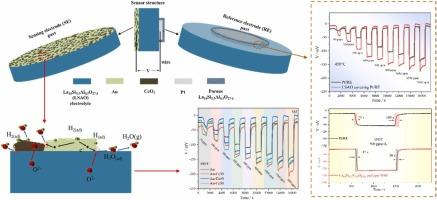A La10Si5.5Al0.5O27-δ based mixed-potential H2 sensor using Au-CeO2 composite sensing electrode
IF 3.7
1区 化学
Q1 CHEMISTRY, ANALYTICAL
引用次数: 0
Abstract
Herein, a high-temperature applicable hydrogen sensor was prepared using a highly catalytically active Au-CeO2 composite as a sensing electrode loaded on La10Si5.5Al0.5O27-δ electrolyte (LSAO). The CeO2 addition hinders the sintering of Au and leads to forming the porous three-dimensional structure of the sensing electrode. Moreover, CeO2 oxygen ion conduction enlarges the electrode reaction active sites, which improves the response performance of the sensor. Among all sensors, the sensor based on Au-40 wt% CeO2 sensing electrode exhibits the largest response value and the highest sensitivity (-86.20 mV/decade) in 50–2000 ppm H2 at 450°C. The Pt reference electrode covered by porous LSAO coating enhances the sensor sensitivity and shortens response and recovery time. When 50 ppm NO, 50 ppm NO2, 1000 ppm CO or 2000 ppm CH4, was introduced to test gas containing 500 ppm H2, the response value change rate is + 0.35 %, −1.34 %, + 0.04 % and −0.61 %, respectively, showing that the sensor has excellent anti-interference for those interfering gases. The humidity and CO2 have a greater effect on the sensor response, and 40 % humidity or 24 % CO2 coexisting with 500 ppm H2 causes the response decreases by −19.25 % or −8.89 %. However, it should be noticed that the sensor response signal has a little change over a wide concentration range of humidity or CO2 (3–40 vol% humidity or 3–24 % CO2). In addition, the sensor also shows good stability and reproducibility. The mixed potential mechanism of the sensor is verified using Tafel and polarization methods.

基于Au-CeO2复合传感电极的La10Si5.5Al0.5O27-δ混合电位H2传感器
本文采用高催化活性的Au-CeO2复合材料作为传感电极,负载在La10Si5.5Al0.5O27-δ电解质(LSAO)上,制备了一种高温适用的氢传感器。CeO2的加入阻碍了Au的烧结,导致传感电极的多孔三维结构的形成。此外,CeO2氧离子的传导扩大了电极的反应活性位点,提高了传感器的响应性能。在所有传感器中,基于Au-40 wt% CeO2传感电极的传感器在50-2000 ppm H2和450°C条件下具有最大的响应值和最高的灵敏度(-86.20 mV/decade)。多孔LSAO涂层覆盖的Pt参比电极提高了传感器的灵敏度,缩短了响应和恢复时间。当引入50 ppm NO、50 ppm NO2、1000 ppm CO或2000 ppm CH4检测含500 ppm H2的气体时,响应值变化率分别为+0.35%、-1.34%、+0.04%和-0.61%,表明该传感器对这些干扰气体具有良好的抗干扰性。湿度和CO2对传感器响应的影响较大,40%湿度或24% CO2与500 ppm H2共存时,传感器响应分别降低-19.25%和-8.89%。但是,应该注意的是,传感器响应信号在较宽的湿度或CO2浓度范围内(3-40 vol%湿度或3-24% CO2)变化不大。此外,该传感器还具有良好的稳定性和再现性。利用Tafel法和偏振法验证了传感器的混合电位机理。
本文章由计算机程序翻译,如有差异,请以英文原文为准。
求助全文
约1分钟内获得全文
求助全文
来源期刊

Sensors and Actuators B: Chemical
工程技术-电化学
CiteScore
14.60
自引率
11.90%
发文量
1776
审稿时长
3.2 months
期刊介绍:
Sensors & Actuators, B: Chemical is an international journal focused on the research and development of chemical transducers. It covers chemical sensors and biosensors, chemical actuators, and analytical microsystems. The journal is interdisciplinary, aiming to publish original works showcasing substantial advancements beyond the current state of the art in these fields, with practical applicability to solving meaningful analytical problems. Review articles are accepted by invitation from an Editor of the journal.
 求助内容:
求助内容: 应助结果提醒方式:
应助结果提醒方式:


